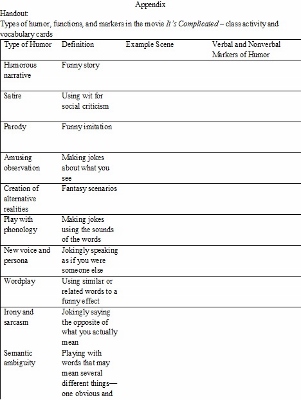|
At the 2014 TESOL International Convention & English
Language Expo in Portland, Oregon, this presentation shared the findings
of a doctoral dissertation mixed-methods study (Petkova, 2013) in
teaching American humor competence to international students in an
intensive English program (IEP) in southern California. It was an
amazing feeling to see a crowded room of fellow ESL/EFL teachers,
researchers, and administrators, many of whom remained standing till the
end and asked numerous questions about humor in different languages and
cultures.
The idea to use video clips as part of a humor competence
curriculum is based on a study of bilingual cross-cultural couples by
Chiaro (2009). The couples in this study reported enjoying humorous
videos together, but when one partner did not understand a joke, they
would pause the video and translate or explain the background
information needed to get the joke. Having been together for more than
10 years, these couples eventually were able to understand, appreciate,
and even produce their partner’s cultural types of humor in their
partner’s native language.
As Morain proposed in 1991, our humor competence curriculum was
organized thematically by focusing on humor in the areas of social
interaction, work, language, and the intellect. It also followed Wulf’s
(2010) taxonomy of humor devices, based on Attardo’s, Hempelmann’s and
Di Maio’s (2002), including observational humor, irony, sarcasm,
ambiguity, exaggeration, allusions, teasing, self-deprecating humor,
alternate realities, and metaphors. The videos selected to represent
examples of these themes and types of humor were from clips of people
(Jerry Seinfeld, Jim Carrey, Bill Cosby, Russell Peters, Jimmy Fallon,
Woody Allen, David Letterman, Jay Leno, and Gabriel Garcia “Fluffy”) and
from shows and movies (Friends, The Big
Bang Theory, Car Talk, The Office, Politically
Incorrect, Saturday Night Live, The Tonight Show, Shrek, It’s Complicated).
Thirty-five young adults, mostly (90%) from China and Saudi
Arabia, 66% male, enrolled in two sections of a low advanced
listening/note-taking IEP class, watched and discussed the videos over a
period of 8 weeks, twice a week for about 20 minutes. They also studied
humor-related vocabulary, kept humor journals, and engaged in humorous
role-play activities, but the video clips described above were always
everyone’s favorites, especially those from Friends
and The Big Bang Theory. Every clip was also
accompanied by a handout (see the Appendix) explaining various types of
conversational humor, and the students were asked to find examples of
each type in the video, as well as describe the verbal and nonverbal
markers of humor they noticed in that particular scene.
At the end of the 8 weeks’ study, a paired-samples t-test (95%
level of confidence) found statistically significant improvement in
students’ perceptions and comprehension of comedy videos in English.
Students’ journals also showed improved perceptions of English humor, in
addition to very positive humor competence curriculum evaluations.
Students believed humor competence instruction was needed and could be
helpful in the classroom.
REFERENCES
Attardo, S., Hempelmann, C. F., & Di Maio, S. (2002).
Script oppositions and logical mechanisms: Modeling incongruities and
their resolutions. Humor, 15, 3–46.
Chiaro, D. (2009). Cultural divide or unifying factor? Humorous
talk in the interaction of bilingual, cross-cultural couples. In N.
Norrick & D. Chiaro (Eds.), Humor in interaction (pp. 211–231). Philadelphia, PA: John Benjamins.
Morain, G. G. (1991). X-raying the international funny bone: A
study exploring differences in the perception of humor across culture. Georgetown University Round Table on Languages and Linguistics,397–408.
Petkova, M. H. (2013). Effects and perceptions of a
humor competence curriculum in an intensive English program in southern
California. (Doctoral dissertation <Copyeditor note: Is
this a doctoral dissertation or master’s thesis? Please
verify.>). Available from ProQuest Dissertations and Theses
database. (1294848550).
Wulf, D. (2010). A humor competence curriculum. TESOL Quarterly, 44, 155–169.
Dr. Maria Petkova has been learning and teaching ESL/EFL for
more than 35 years in Bulgaria, the United Arab Emirates, and the United
States of America. Her research interests focus primarily on vocabulary
and pragmatic competence.
Appendix (click to enlarge)

|

